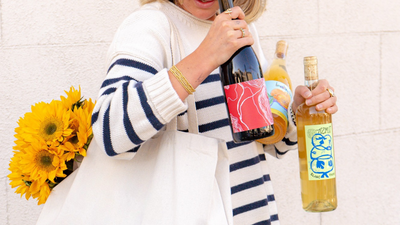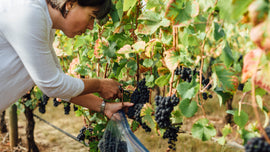The process of taking fruit and transforming sugar into alcohol is very much a scientific exercise. As I have learned more about (and consumed more) wine, my appreciation for the beauty created by the synergy between art and science has grown. Making wine tells a story of the soil where the grapes are grown, to the struggle of the vines to produce fruit, and finally to the process that the winemaker goes through to craft a final product. There are very few areas in life where science and art intersect, and winemakers are a unique mix of the two. Winemaking has always had a romantic allure, but scientifically, making wine is all about chemistry. Somewhere I read, “Strip away the scientific side of the equation and you are left with a guy in a beret playing with his grapes.” Our producers this month are both artisans and scholars, and thanks to their scientific and creative abilities, we are able to enjoy one of life’s greatest pleasures.
Carol Shelton was among the first women to graduate from UC-Davis with a degree in enology. She declared her major as Fermentation Science under the tutelage of Ann Noble, the author of the Aroma Wheel, and threw herself into her enology studies. She also had the great fortune to work with legendary winemakers Robert Mondavi and André Tchelistcheff in California, and Peter Lehmann in Australia. Her time making wine with these wine industry icons would be invaluable as she forged a career as a winemaker in Sonoma County. After a couple of decades as winemaker for Windsor Vineyards, where she had the opportunity to bottle 45 different wines each year ranging from sparkling wines to port, she and her husband Mitch Mackenzie started their own winery in 2000.
Carol has been lauded with countless medals and honors through the course of her 35-year winemaking career. In fact, she is said to be one of the most awarded winemakers in the country. Early in her career, Carol experienced some of the resistance that many of her pioneering class of women winemakers were encountering. In her own words: “women weren’t allowed to work in the cellar. We weren’t considered strong enough, but I think many of us proved this conception to be dead wrong: by hauling hoses, pushing around pumps, shoveling out a tank full of grapes – and yes it’s hard physical labor, but women can do it.”
Based out of an industrial park in the city of Santa Rosa, Carol continues to meticulously hand-craft her wines. Carol and Mitch have sought out exceptional vineyards throughout California including Dry Creek Valley, Rockpile, Russian River Valley, Fountaingrove District, Paso Robles, Lodi, Mendocino County, and the Cucamonga Valley of Southern California. Many of her vineyard sources are organically grown, dry farmed and many decades old. She develops close partnerships with each grower to ensure her wines maintain and express the unique terroir of the vineyard. She prefers to concentrate on quality and keeps her production to about 5,000 cases per year. Recently, she added a few non-Zinfandel varietals.
In 2008, Carol created the first version of a white wine to commemorate her 10th anniversary as a winery and called it “Coquille Blanc”. Coquille is pronounced “ko-keel” and it is French for shellfish or scallop, like the scallop shells on the Shelton family coat of arms. The wine was so popular that she has continued to make it ever since.
All the fruit for the Coquille Blanc is sourced from the Nevarez Vineyard in Paso Robles. Nevarez Vineyard is a family-owned business located on 75 acres of land within the Paso Robles AVA. Juan Nevarez worked his way from farm laborer, to an organizer for Cesar Chavez, to becoming the founding vineyard manager for Justin Winery, to eventually owning his own winery. The fruit of Nevarez Vineyard continues to be purchased by established wineries in the Central Coast and in Northern California areas, and Nevarez has won two "Grower of the Year" awards. Juan Nevarez has become the first Mexican vineyard/winery owner in San Luis Obispo County.
While “Zin is her Zen”, Shelton’s versatility, experience and creativeness know no bounds when it comes to creating a flavorful wine. That’s what is seen in her Coquille Blanc. The 2018 is a blend of 38% Grenache Blanc, 22% Roussanne, 28% Viognier, and 12% Marsanne. The wine was 100% barrel fermented, with the lees stirred every Wednesday for 8 months, and about 50% of the wine underwent malolactic fermentation. The 2018 was aged for 9 months in all French oak barrels: 15% 1-yr-old, 15% 2-3-yr-old Acacia, 70% older/neutral. Only 986 cases were produced.
The 2018 Coquille is full-bodied, blissfully crisp and yet creamy. It offers intriguing aromatics, displaying pear and stone fruit, lots of spice, and hints of flowers, nuts, and earth, with a fairly rich, mouth-filling texture that is balanced by good acidity that leads to a long finish. It’s a wine that can go the distance, from first course to last, especially with lobster and scallops, chicken and pork dishes both covered in creamy sauces (or not).
The 2018 Carol Shelton Coquille Blanc is $22.00/bottle, $237.60/case.
The wine known as Valpolicella is arguably the most famous red wine to come out of the Veneto in northern Italy. Winemaking in the region dates back to at least the times of the ancient Greeks. The name itself, Valpolicella, comes from Latin and Greek, and means “valley of many cellars”. The Valpolicella Viticultural Area is located in the province of Verona, east of Lake Garda, north of the Adige River. The variety of terroir and meager soils on the volcanic hills and in the alluvial valleys along the rivers were left by ancient volcanic activity: a mix of volcanic tufa, calcareous clays and, in the east, alluvial material. As a result, the Valpolicella region is ideal for the cultivation of wine grapes, with the possibility to cultivate a wide variety of wine grapes. The main grape varieties are Corvina, Corvinone, Rondinella, and Molinara. The tannic, thick-skinned Corvina is regarded the best suited to the region, and the DOC law was updated in 2010 allowing up to 95% to be used. Corvinone has similar characteristics to Corvina and was recognized as a variety in its own right, as opposed to a mutant of Corvina, in 1993. In addition, unique local grapes are grown like Rossignola, Negrara Trentina, and Barbera, alongside Merlot, Cabernet Sauvignon, and Sangiovese.
The finest terroir in the Valpolicella DOC is to be found in the Classico zone, located just to the northwest of Verona, and consisting of three vertically-running valleys - Fumane, Marano and Negrar. From west to east, there are five main communes, named after its largest or most important town within them: Sant'Ambrogio di Valpolicella, San Pietro in Cariano, Fumane, Marano di Valpolicella, and Negrar.
There are 5 levels or styles of Valpolicella; Classico, Superiore, Superiore-Ripasso, Amarone della Valpolicella, and Recoito della Valpolicella. The winemaking process for Amarone, called “Appassimento”, entails the drying of grape bunches after harvest for up to 4 months, allowing them to shrivel like raisins before pressing, vinifying and aging. Ripasso is generally less well known than Valpolicella Classico and Amarone, even though it shares some features of both wines. Then name Ripasso refers to its production process whereby regular, fermented Valpolicella is added to a cask containing the skins and lees left over from recently fermented Amarone wines. The process of adding (or “repassing”) the lighter Valpolicella wine over the remainders of the “bigger” Amarone wine imparts additional color, texture and flavor to the wine. Also, it induces a second fermentation of the wine that increases the wine’s alcoholic content.
In 1958, Domenico Fraccaroli started his wine business in the town of Paradiso di Pocenia, in a neighboring region of Friuli Venezia Giulia, producing both aromatic white and firm red wines. In 2002, his son Tiziano decided to broaden the range of wines the family produced. He started Grotta del Ninfeo in the small town of Lavagno, located about 56 miles west of Venice, and about 7 miles east of Verona. On a farm that dates back to Roman times, he started producing wines of the area -Valpolicella, Amarone, Ripasso and Recioto. Currently Tiziano’s sons Domenico and Luca and his daughter Maria are actively contributing to the company’s success, continuing the legacies created by their grandfather Domenico and father Tiziano. Grotta del Ninfeo’s vineyards are located in the renowned Val di Mezzane at an altitude of 150 meters above sea level. Perhaps the best-preserved valley of the Province, Valle di Mezzane is renowned for its fertile terrain, due to the abundance of streams and brooks which always nourished its agricultural trade.
Domenico Fraccaroli’s 2016 Grotta del Ninfeo Ripasso della Valpolicella is a blend of 70% Corvina, 20% Rondinella, and 10% Molinara. Harvested by hand, the grapes are de-stemmed, crushed and cold soaked for 5 days with native yeast leading to spontaneous fermentation. Maturation and fermentation are carried out in vertical vats under controlled temperature for 8 days. In early January, the wine referments on Amarone grape skins according to the “Ripasso” method for 4 days. The wine is then drained off and racked in French oak tonneaux for 12 months, and rests in the bottle for 8 months before being released. The 2016 Grotta del Ninfeo Ripasso reveals a delicious, complex nose with hints of laurel, coffee, molasses, red and black currants and lots more. In the mouth, it is very complex, spicy, and very vibrant with balsamic texture, dark fruits, and bitter tones that give the whole thing a nice edge. The finish is balanced, long and lingering. It is the perfect wine to have with red meats, stews, and strong-flavored cheeses. I always love to make a risotto with radicchio, pancetta, and Gorgonzola to pair with this wine.
Domenico Fraccaroli’s 2016 Grotta del Ninfeo Ripasso della Valpolicella is $27.00/bottle, $291.60/case





